
Director’s Note:
It all started back in early March when I took a half-day bus ride with some friends to the quaint town of Sagada, in the middle of the Cordilleras, almost four hundred kilometers north of Manila. I was there for the inauguration of a restored mural in an Episcopalian school by the late Santiago “Santi” Bose. He is known for his multimedia works, which specifically explore Filipino identity after colonialism and address the social and political by way of his indigeneity. I was there as a friend of the artist Kawayan de Guia, son of my mentor Kidlat Tahimik, who initiated the project around his own mentor. I was also there because of my Santi tattoo, a fragment of Bose’s drawings that are based on folk amulets, which criticize our Catholic dogmatism while emphasizing the true nature of folk spirituality. I was there because a few days before coming, another friend sent me my lunar nodes that encompass the concept of past life and future trajectory. Santi was known as a “wild man” to those close to him, and this particular imagining was also reflected in my astrological chart. Our weekend trip turned into a full-blown lockdown for months, after the quarantine was officially imposed nationwide. We felt that it was safer in the mountains and ended up sharing space with a number of creatives (painter, chef, writer, archivist) in the home of our friend Nona Garcia, another artist who was also part of the collective gathering. I found myself living in a community of artists next to a forest, different from my home back in Manila in quite a number of ways. Nona was also taking care of several animals that were more family than pets. Soon, I began to learn the unspoken language of nature: the spirit of gestures, what the winds mean, and the rhythm of light and dark.
During the lockdown, it became harder to grasp a sense of time while also becoming tired of watching screens. Eventually, all images were the same, so this led me to read about film instead, and I discovered a curious footnote in the history of Philippine cinema. I revisited an earlier tweet I had written about the Japanese stealing all film materials from the Philippines and sending them back to Japan to train their filmmakers during the Occupation, a fantastical deduction of the Filipino influence in the golden age of Japanese cinema: that we might have had a hand in training the “western” voice in Kurosawa, or something like that. This led me to discover the strange story of a Japanese filmmaker who took over the national consciousness by prescribing fascist militarist aesthetics through what he called “Spiritist Cinema.” In the absence of moving images for this story, I went through publicly available clips and reels, from the history of Japanese ultranationalism to a rare glimpse of Malay mysticism. The idea of scouring for spirit within these digital non-spaces through the gaze of colonizers perpetuating the war narrative at the time, and reclaiming them first through cutting then through dreaming about them through AI coloring . . . It was akin to necromancy, to borrow from magick, so the effort becomes collective: eventually, I had to work with different people in different locations, trying to rebuild the spirit of the past, only linked by the energetic architecture of the internet. In the absence of a film laboratory, our cinematographer “processed” these clips by cutting them down into small phone “reels” and feeding them through an app. Similarly, our sound designer connected with natural sounds through a virtual network of archives. It seemed that, in the absence of a theater, the theatrical presence of cinema was enough to reconstruct the non-images into a somewhere else: the space, cinema. “How do we watch movies without cinema?” I think about my two uncles and aunt who recently died from the virus, disappearing into the void just like that. What are they watching from beyond? And how are those images made? There’s always been collectivity, even before, and after, cinema.
- Year2020
- Runtime20 minutes
- CountryPhilippines/Singapore
- DirectorRaya Martin
Director’s Note:
It all started back in early March when I took a half-day bus ride with some friends to the quaint town of Sagada, in the middle of the Cordilleras, almost four hundred kilometers north of Manila. I was there for the inauguration of a restored mural in an Episcopalian school by the late Santiago “Santi” Bose. He is known for his multimedia works, which specifically explore Filipino identity after colonialism and address the social and political by way of his indigeneity. I was there as a friend of the artist Kawayan de Guia, son of my mentor Kidlat Tahimik, who initiated the project around his own mentor. I was also there because of my Santi tattoo, a fragment of Bose’s drawings that are based on folk amulets, which criticize our Catholic dogmatism while emphasizing the true nature of folk spirituality. I was there because a few days before coming, another friend sent me my lunar nodes that encompass the concept of past life and future trajectory. Santi was known as a “wild man” to those close to him, and this particular imagining was also reflected in my astrological chart. Our weekend trip turned into a full-blown lockdown for months, after the quarantine was officially imposed nationwide. We felt that it was safer in the mountains and ended up sharing space with a number of creatives (painter, chef, writer, archivist) in the home of our friend Nona Garcia, another artist who was also part of the collective gathering. I found myself living in a community of artists next to a forest, different from my home back in Manila in quite a number of ways. Nona was also taking care of several animals that were more family than pets. Soon, I began to learn the unspoken language of nature: the spirit of gestures, what the winds mean, and the rhythm of light and dark.
During the lockdown, it became harder to grasp a sense of time while also becoming tired of watching screens. Eventually, all images were the same, so this led me to read about film instead, and I discovered a curious footnote in the history of Philippine cinema. I revisited an earlier tweet I had written about the Japanese stealing all film materials from the Philippines and sending them back to Japan to train their filmmakers during the Occupation, a fantastical deduction of the Filipino influence in the golden age of Japanese cinema: that we might have had a hand in training the “western” voice in Kurosawa, or something like that. This led me to discover the strange story of a Japanese filmmaker who took over the national consciousness by prescribing fascist militarist aesthetics through what he called “Spiritist Cinema.” In the absence of moving images for this story, I went through publicly available clips and reels, from the history of Japanese ultranationalism to a rare glimpse of Malay mysticism. The idea of scouring for spirit within these digital non-spaces through the gaze of colonizers perpetuating the war narrative at the time, and reclaiming them first through cutting then through dreaming about them through AI coloring . . . It was akin to necromancy, to borrow from magick, so the effort becomes collective: eventually, I had to work with different people in different locations, trying to rebuild the spirit of the past, only linked by the energetic architecture of the internet. In the absence of a film laboratory, our cinematographer “processed” these clips by cutting them down into small phone “reels” and feeding them through an app. Similarly, our sound designer connected with natural sounds through a virtual network of archives. It seemed that, in the absence of a theater, the theatrical presence of cinema was enough to reconstruct the non-images into a somewhere else: the space, cinema. “How do we watch movies without cinema?” I think about my two uncles and aunt who recently died from the virus, disappearing into the void just like that. What are they watching from beyond? And how are those images made? There’s always been collectivity, even before, and after, cinema.
- Year2020
- Runtime20 minutes
- CountryPhilippines/Singapore
- DirectorRaya Martin
